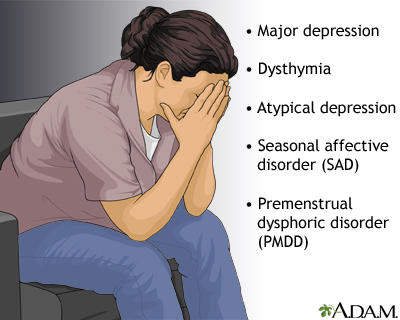Seasonal affective disorder
Seasonal depression; Winter depression; Wintertime blues; SAD
Seasonal affective disorder (SAD) is a type of depression that occurs at a certain time of the year, usually in winter.
Images

I Would Like to Learn About:
Causes
SAD may begin during the teen years or in adulthood. Like other forms of depression, it occurs more often in women than in men.
People who live in places with long winter nights are at high risk of developing SAD. A less common form of the disorder involves depression during the summer months.
Symptoms
Symptoms usually build up slowly in the late autumn and winter months. Symptoms are often the same as with other forms of depression:
- Hopelessness
- Increased appetite with weight gain (weight loss is more common with other forms of depression)
- Increased sleep (too little sleep is more common with other forms of depression)
- Less energy and ability to concentrate
- Loss of interest in work or other activities
- Sluggish movements
- Social withdrawal
- Unhappiness and irritability
SAD can sometimes become long-term depression. Bipolar disorder or thoughts of suicide are also possible.
Exams and Tests
There is no test for SAD. Your health care provider can make a diagnosis by asking about your history of symptoms.
Your provider may also perform a physical exam and blood tests to rule out other disorders that have symptoms similar to SAD.
Treatment
As with other types of depression, antidepressant medicines and talk therapy can be effective.
MANAGING YOUR DEPRESSION AT HOME
To manage your symptoms at home:
- Get enough sleep.
- Eat healthy foods.
- Take medicines the right way. Ask your provider how to manage side effects.
- Learn to watch for early signs that your depression is getting worse. Have a plan if it does get worse.
- Try to exercise more often. Do activities that make you happy.
Do not use alcohol or illegal drugs. These can make depression worse. They can also cause you to think about suicide.
When you are struggling with depression, talk about how you are feeling with someone you trust. Try to be around people who are caring and positive. Volunteer or get involved in group activities.
LIGHT THERAPY
Your provider may prescribe light therapy. Light therapy uses a special lamp with a very bright light that mimics light from the sun:
- Treatment is started in the fall or early winter, before the symptoms of SAD begin.
- Follow your provider's instructions about how to use light therapy. One way that may be recommended is to sit 2 feet (60 centimeters) away from the light box for about 30 minutes each day. This is often done in the early morning, to mimic sunrise.
- Keep your eyes open, but do not look straight into the light source.
If light therapy is going to help, symptoms of depression should improve within 3 to 4 weeks.
Side effects of light therapy include:
- Eye strain or headache
- Mania (rarely)
People who take medicines that make them more sensitive to light, such as certain psoriasis medicines, antibiotics, or antipsychotics, should not use light therapy.
A checkup with your eye doctor is recommended before starting treatment.
With no treatment, symptoms usually get better on their own with the change of seasons. Symptoms can improve more quickly with treatment.
Outlook (Prognosis)
The outcome is usually good with treatment. But some people have SAD throughout their lives.
When to Contact a Medical Professional
If you or someone you know is thinking about suicide, call or text 988 or chat 988lifeline.org. You can also call 1-800-273-8255 (1-800-273-TALK). The 988 Suicide and Crisis Lifeline provides free and confidential support 24/7, anytime day or night.
You can also call 911 or the local emergency number or go to the hospital emergency room. DO NOT delay.
If someone you know has attempted suicide, call 911 or the local emergency number right away. DO NOT leave the person alone, even after you have called for help.
Related Information
DepressionReferences
American Psychiatric Association website. Depressive disorders. Diagnostic and Statistical Manual of Mental Disorders. 5th ed. Text Revision (DSM-5-TR), Washington, DC: American Psychiatric Association Publishing; 2022.
Fava M, Mischoulon D, Cassano P, Papakosta GI, Stern TA. Depressive disorders. In: Stern TA, Wilens TE, Fava M, eds. Massachusetts General Hospital Comprehensive Clinical Psychiatry. 3rd ed. Philadelphia, PA: Elsevier; 2025:chap 28.
Lyness JM, Lee HB. Psychiatric disorders in medical practice. In: Goldman L, Cooney KA, eds. Goldman-Cecil Medicine. 27th ed. Philadelphia, PA: Elsevier; 2024:chap 362.
National Institute of Mental Health website. Seasonal affective disorder. www.nimh.nih.gov/health/publications/seasonal-affective-disorder. Revised 2023. Accessed May 30, 2024.
BACK TO TOPReview Date: 5/4/2024
Reviewed By: Fred K. Berger, MD, addiction and forensic psychiatrist, Scripps Memorial Hospital, La Jolla, CA. Also reviewed by David C. Dugdale, MD, Medical Director, Brenda Conaway, Editorial Director, and the A.D.A.M. Editorial team.

Health Content Provider
06/01/2025
|
A.D.A.M., Inc. is accredited by URAC, for Health Content Provider (www.urac.org). URAC's accreditation program is an independent audit to verify that A.D.A.M. follows rigorous standards of quality and accountability. A.D.A.M. is among the first to achieve this important distinction for online health information and services. Learn more about A.D.A.M.'s editorial policy, editorial process and privacy policy. A.D.A.M. is also a founding member of Hi-Ethics. This site complied with the HONcode standard for trustworthy health information from 1995 to 2022, after which HON (Health On the Net, a not-for-profit organization that promoted transparent and reliable health information online) was discontinued. |
The information provided herein should not be used during any medical emergency or for the diagnosis or treatment of any medical condition. A licensed medical professional should be consulted for diagnosis and treatment of any and all medical conditions. Links to other sites are provided for information only -- they do not constitute endorsements of those other sites. © 1997- 2025 A.D.A.M., a business unit of Ebix, Inc. Any duplication or distribution of the information contained herein is strictly prohibited.
